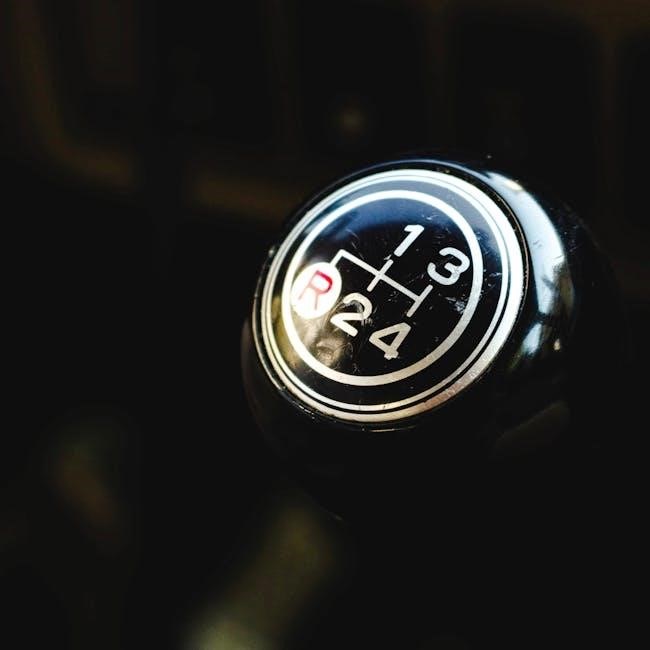A stall converter in a manual transmission enhances torque multiplication during low-speed acceleration, improving responsiveness and performance in racing and heavy-duty applications.
Understanding the Basics
A stall converter in a manual transmission is a critical component that regulates torque multiplication between the engine and the transmission. It operates by allowing the engine to maintain a higher RPM while the transmission gears engage, enabling smoother acceleration and improved low-speed performance. The stall converter consists of three main parts: the impeller, turbine, and stator, which work together to optimize power delivery. Unlike automatic transmissions, manual systems require precise driver input, and the stall converter ensures efficient energy transfer during gear shifts. By adjusting the stall speed, drivers can customize the vehicle’s responsiveness, making it ideal for racing or heavy-duty applications where quick acceleration is essential.
Importance in Modern Vehicles
In modern vehicles, the stall converter plays a pivotal role in enhancing drivetrain efficiency, particularly in manual transmissions. By optimizing torque delivery, it ensures smoother acceleration and reduces wear on clutch systems. This component is especially crucial in high-performance and racing applications, where rapid gear changes and high RPM operations are common. Modern stall converters often feature advanced lock-up technologies, which improve fuel efficiency by minimizing slippage during cruising speeds. Their ability to adapt to varying driving conditions makes them indispensable in contemporary automotive engineering, balancing performance and reliability for both everyday driving and specialized use cases.

History and Development
The stall converter evolved from early torque converters, with advancements in materials and design improving performance and efficiency, particularly benefiting racing and high-performance driving applications.
Origins and Evolution
The stall converter traces its origins to the mid-20th century, evolving from traditional torque converters initially designed for automatic transmissions. Early versions focused on improving low-speed acceleration and torque multiplication. Over time, advancements in materials and design led to more efficient and adaptable systems. The integration of stall converters into manual transmissions emerged as a response to the demand for enhanced performance in racing and high-performance vehicles. This evolution allowed for better control over torque delivery, enabling smoother engagement and disengagement processes. Today, modern stall converters combine cutting-edge technology with proven mechanical principles, offering superior performance and reliability across various applications.
Impact on Automotive Industry
The stall converter has significantly influenced the automotive industry by enhancing performance and efficiency in manual transmissions. Its ability to optimize torque delivery at low speeds has made it indispensable in racing and heavy-duty applications. This innovation has led to advancements in transmission technology, enabling smoother engagement and disengagement processes. The automotive sector has embraced stall converters for their role in improving fuel efficiency and reducing emissions, aligning with modern environmental standards. Additionally, the integration of stall converters has spurred technological advancements, driving the development of more sophisticated transmission systems. Their widespread adoption underscores their importance in meeting the demands of both performance-driven and eco-conscious vehicles.

Components of a Stall Converter
A stall converter consists of a torque converter, clutch system, and transmission cooler, working together to optimize torque multiplication and heat management in manual transmissions.
Torque Converter Mechanics
The torque converter operates as a fluid-coupled mechanism, using hydraulic pressure to transfer rotational energy from the engine to the transmission. It houses three main components: the impeller, turbine, and stator. The impeller, driven by the engine’s crankshaft, pumps transmission fluid into the turbine, which connects to the transmission input shaft. The stator, positioned between these two, redirects fluid flow to optimize torque multiplication. This design allows the converter to multiply torque at low engine speeds, enhancing acceleration. Modern converters often feature a lock-up clutch that engages at higher speeds to eliminate slip and improve fuel efficiency. Proper maintenance ensures optimal performance and longevity.
Clutch System Integration
The clutch system in a manual transmission equipped with a stall converter plays a crucial role in disengaging the engine from the transmission during gear shifts. When the driver presses the clutch pedal, it releases the pressure plate, separating the clutch disc from the flywheel. This allows the driver to shift gears smoothly without grinding. The stall converter enhances low-speed torque, but the clutch remains essential for manual gear changes. Proper synchronization between the clutch and converter ensures efficient power transfer. Improper engagement can lead to wear on both components, emphasizing the need for precise driver input and regular maintenance to maintain optimal performance and longevity.
Transmission Cooler Role
The transmission cooler is essential for maintaining optimal temperatures within the manual transmission system, especially when paired with a stall converter. It circulates coolant through the transmission, dissipating heat generated by friction and torque multiplication. Overheating can degrade transmission fluid and damage components, so the cooler ensures longevity and performance. Proper installation and maintenance of the cooler are critical, particularly in high-stress applications like racing or heavy-duty use. Regular servicing, such as fluid checks and cleaning, helps prevent overheating issues and maintains the system’s efficiency, ensuring smooth operation and reliability under various driving conditions and power demands.

Functionality in Manual Transmission
The stall converter optimizes low-speed torque multiplication, enhancing acceleration and responsiveness, while the clutch system enables smooth engagement and disengagement, ensuring precise control over power delivery.
Engagement and Disengagement Process
The engagement and disengagement process in a manual transmission with a stall converter involves the clutch pedal, which disconnects the engine from the transmission. When the driver presses the clutch, the torque converter disengages, allowing the turbine to spin freely. This process enables smooth gear shifts without grinding. The stall converter maintains torque multiplication during low-speed operation, ensuring consistent power delivery. As the clutch pedal is released, the converter re-engages, seamlessly connecting the engine to the transmission. This mechanism enhances acceleration and responsiveness, particularly in racing and performance driving scenarios, where quick and precise control is critical for optimal performance. Proper synchronization ensures efficient power transfer and minimizes wear on transmission components.
Stall Speed vs. Engine RPM
Stall speed in a manual transmission is directly linked to engine RPM, determining how the torque converter engages and disengages. A lower stall speed corresponds to lower engine RPM, providing smoother acceleration in city driving. Higher stall speeds, typically used in racing, allow the engine to reach higher RPM before the converter locks up, maximizing power output. The balance between stall speed and RPM is crucial for optimal performance, ensuring the vehicle accelerates efficiently without wasting power. Proper tuning of these parameters enhances responsiveness and fuel efficiency, making it essential for drivers to match their stall converter specifications to their driving conditions and vehicle setup.

Applications of Stall Converter
Stall converters are widely used in racing for rapid acceleration and in heavy-duty vehicles for towing, enhancing torque multiplication and improving overall performance in demanding conditions.
Racing and Performance Driving
In racing, stall converters optimize acceleration by increasing torque multiplication at low speeds, allowing vehicles to achieve higher RPM before engaging the clutch. This enhances launch performance and reduces lag, making it ideal for drag racing and high-performance applications. Performance drivers benefit from improved responsiveness, enabling quicker shifts and better control during aggressive driving. The ability to customize stall speeds further tailors the converter to specific engine characteristics, ensuring maximum power delivery. This results in faster lap times and superior acceleration, making stall converters a critical component in competitive racing environments. Their adaptability to various racing conditions underscores their importance in performance driving scenarios.
Heavy-Duty and Industrial Uses
Stall converters are essential in heavy-duty and industrial applications, where consistent torque multiplication is critical for handling large loads. Their ability to maintain torque during low-speed operations ensures smooth engagement in heavy machinery and trucks, preventing stalling under heavy loads. Industries such as construction and logistics rely on these converters for their durability and performance. Customizable stall speeds allow for optimization in specific industrial settings, enhancing efficiency and reducing wear on equipment. This reliability makes stall converters indispensable in demanding environments, ensuring seamless operation and minimizing downtime. Their robust design withstands rigorous use, making them a vital component in industrial and heavy-duty transmissions.

Installation Guide
Installing a stall converter requires dropping the transmission to access the torque converter. Remove the old converter, replace the seal, and apply ATF before reinstallation for smooth operation.
Step-by-Step Installation Process
Begin by raising the vehicle and removing the transmission to access the torque converter. Carefully pull the converter straight out, taking note of its position. Inspect the transmission housing for any debris. Install a new seal, ensuring it’s properly seated. Apply a thin layer of ATF to the converter’s surface where it contacts the seal. Align the converter with the transmission input shaft and push it in until it clicks. Reinstall the transmission, ensuring all bolts are securely tightened. Finally, refill the transmission fluid and test drive the vehicle to ensure proper operation and engagement.

Maintenance and Care
Regularly inspect the transmission fluid level and condition, ensuring it’s clean and at the recommended level. Avoid over-tightening connections to prevent damage to the converter.
Regular Servicing Tips
Regular servicing ensures optimal performance and longevity of the stall converter. Check the transmission fluid level and condition, replacing it as recommended by the manufacturer. Inspect the torque converter for any signs of wear or damage, such as leaks or unusual noises. Clean or replace the filter to maintain proper fluid flow. Avoid extreme temperatures and ensure the cooling system functions correctly. Always refer to the manual for specific guidelines tailored to your vehicle. Promptly address any issues to prevent costly repairs and maintain smooth operation. Regular maintenance is key to preserving the efficiency and reliability of your manual transmission system.
Best Practices for Longevity

To maximize the lifespan of a stall converter in a manual transmission, adopt best practices such as avoiding aggressive driving and extreme temperatures. Ensure proper installation by following the manufacturer’s guidelines. Regularly check and maintain the correct transmission fluid level to prevent overheating. Avoid excessive preload on the torque converter, as it can cause premature wear. Inspect the system for any leaks or unusual noises and address them promptly. Store the vehicle in a cool, dry place when not in use to prevent corrosion. By adhering to these practices, you can significantly extend the life of your stall converter and maintain optimal performance over time.

Performance Optimization
Adjusting the stall speed and ensuring proper transmission fluid levels can significantly enhance acceleration and overall efficiency in manual transmissions with a stall converter installed.
Enhancing Acceleration
Optimizing the stall converter’s performance is crucial for improving acceleration in manual transmissions. By carefully selecting the right stall speed, drivers can achieve quicker launches and smoother power delivery. Lower stall speeds are often preferred for street driving, as they provide better low-end torque, making acceleration feel more responsive. Conversely, higher stall speeds are ideal for racing applications, allowing engines to stay within their power band during shifts. Proper clutch engagement and disengagement techniques also play a significant role in maximizing acceleration. Regular maintenance, such as ensuring the torque converter is functioning correctly and the transmission fluid is clean, further enhances performance. These adjustments collectively contribute to a more efficient and powerful driving experience.
Improving Fuel Efficiency
Optimizing the stall converter in a manual transmission can significantly enhance fuel efficiency. By reducing unnecessary RPM flares during acceleration and deceleration, drivers can achieve better mileage. Proper adjustment of the stall speed ensures the engine operates within its most efficient range, minimizing fuel waste. Additionally, smooth clutch engagement and disengagement techniques reduce wear on the transmission and converter, further improving fuel economy. Regular maintenance, such as ensuring clean transmission fluid and a well-functioning clutch system, also plays a crucial role in maintaining optimal efficiency. These strategies help drivers save fuel while still enjoying the performance benefits of a manual transmission setup.

Troubleshooting Common Issues
Common issues with stall converters include slipping, shuddering, or incorrect stall speeds. These problems often stem from improper installation, low transmission fluid levels, or torque converter damage.
Diagnosing Problems
Diagnosing issues with a stall converter in a manual transmission involves identifying symptoms like slipping, shuddering, or delayed acceleration. These problems often indicate improper installation or wear.
Check for low transmission fluid levels or contamination, as these can impair converter function. Inspect the torque converter for physical damage or excessive play.
Consult the manual for specific diagnostic procedures, such as monitoring stall speeds or performing a transmission fluid flush to ensure optimal performance and longevity.
Solutions and Repairs
Solving stall converter issues often starts with addressing fluid levels and cleanliness. Replace contaminated fluid and filters to restore optimal transmission function.
For damaged converters, replacement is typically necessary. Ensure the new converter matches the vehicle’s specifications for proper operation.
After installation, test the system to confirm improved performance. Regular maintenance can prevent future issues, ensuring the converter operates efficiently and reliably.
The stall converter remains vital for manual transmissions, optimizing performance through improved torque management. Future trends may include advanced materials and intelligent systems for enhanced efficiency.
The stall converter in a manual transmission plays a crucial role in optimizing torque multiplication, enhancing acceleration, and improving overall vehicle performance. It allows the engine to operate within a more efficient RPM range during low-speed driving scenarios. Key benefits include smoother engagement, reduced wear on the clutch system, and improved fuel efficiency in specific conditions. Proper installation and maintenance are essential to ensure longevity and optimal functionality. Understanding the relationship between stall speed and engine RPM is vital for drivers to maximize the system’s potential. Regular servicing and adherence to best practices are recommended to maintain peak performance and reliability over time.
Innovations and Future Directions
Recent advancements in stall converter technology focus on improving efficiency and integration with modern powertrains. Innovations include advanced lock-up systems, smarter torque multiplication controls, and lightweight materials to enhance performance. Electronic controls now optimize stall speed dynamically, adapting to driving conditions for better acceleration and fuel efficiency. Future trends may incorporate hybrid and electric vehicle compatibility, ensuring stall converters remain relevant in evolving automotive landscapes. Researchers are also exploring seamless integration with automated manual transmissions for smoother operation. These innovations aim to balance performance, efficiency, and reliability, paving the way for next-generation manual transmission systems that cater to both traditional and emerging vehicle technologies.